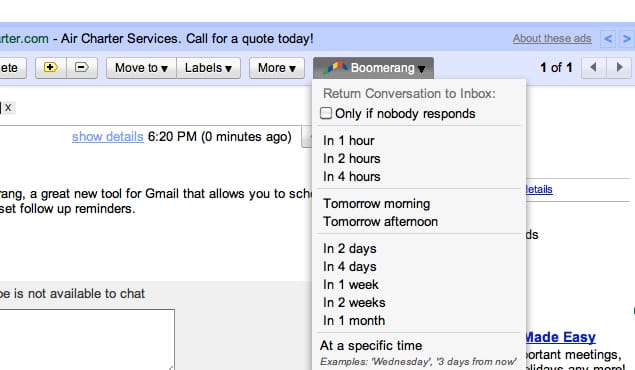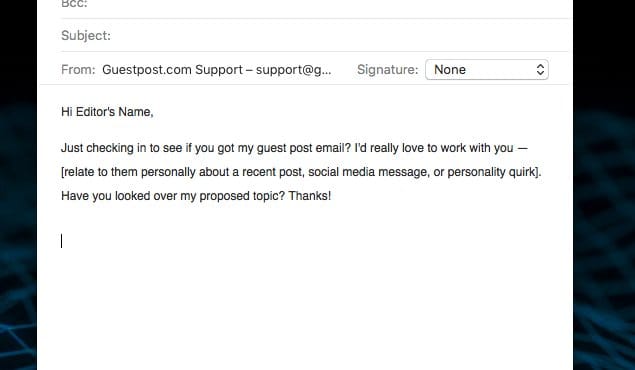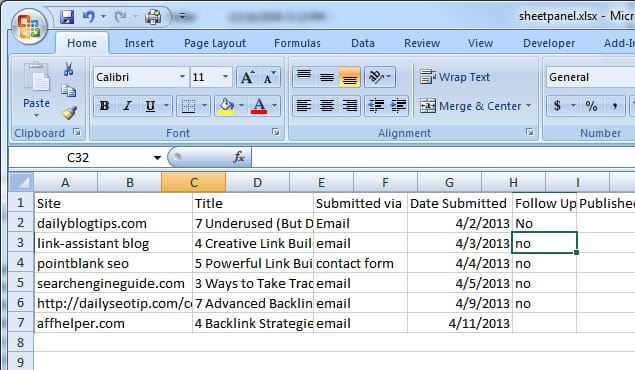All hail the life of the blogger. The individual that spends countless hours researching their topic, diving into real-life experience of said topic, writing into the night about that very same topic, and finally publishing something of value to the internet about the topic.
At least, that’s the ideal blogger. The one who’s doing everything right for the sake of information, and perhaps some personal gain.
The truth is that the blogging field is saturated. Bulging. There’s no clear-cut estimate of how many blogs are on the internet (though you can find an old outdated figure here), but you can bet it’s over 200 million. What’s more, according to Technocrati and Worldometers there are over 2,800,000 blog posts published a day (when I wrote this article).
That’s a lot of content spewing out onto the web.
While some of this content is published by writers on their own blogs, there are large chunks of publications in the guest post category.
What’s more, most bloggers will at some point decide they want (or need) to guest post. Doing so has a huge number benefits, like increasing your site’s exposure, ranking higher with backlinks, and making connections. However, in the same way that blogging is a saturated medium, so is guest posting. There was a cull on guest posts back in 2014 when Google decided to make an example of websites that were using guest post to tweak rankings.
Long story short, guest posting today is much harder to do, and therefore you need to be really skilled to do it well.
There are a bunch of steps to consider, but since you’re here, rather than perusing our article on how to pitch and write a guest post correctly, my guess is that you’ve sent out guest posts and haven’t received a response.
That’s never fun.
There are a number of factors that go into why your guest pitch might have been ignored, which I’ll break down below.
Why Was Your Guest Pitch Ignored?
Hey, don’t beat yourself up. The first rule to remember in this world is that when you put yourself out there, you can’t expect anything in return. That’s true for just about everything, but definitely true about your written word getting a response and publication.
There is something to keep in mind, though. This article is about why your guest pitch was ignored, not why it was denied. Yes, an ignored guest pitch has the same result the same as a denied guest pitch, but the two are very different.
If your guest pitch gets denied, meaning you get a response from the blog you sent it to saying “Sorry, not for us,” you at least got a reply. That’s a good thing, even if they didn’t accept your post. You want responses. In the end, you want positive responses.
Ignoring is another thing entirely. The silence is what’s annoying (or deafening), but it also indicates that you’re not making a compelling email that deserves a response.
I’ll list of some of the very basic guidelines for guest pitches below, the depths of which you can can explore on your own time. Are you doing each of these when you send out a guest pitch?
- Follow the guest post guidelines.
- Learn the editor’s name and use it.
- Introduce your proposed article clearly and effectively.
- State your expertise and background, including other articles you’ve published on the subject.
- Make a real connection with the editor or blog and talk about it in your email.
- Be kind and courteous.
If you’re doing the steps above, you will, most of the time, get a response. Even if it’s a negative response, it’s not very likely your guest pitch will be ignored.
With that said, there is one overarching reason you may still not get a response:
The blog you’re applying to is way too big.
Some popular blogs get hundreds of guest pitches a week. Unless they have a dedicated editorial team, they will probably only respond to the topics they are interested in, or the authors that really compel them.
Think about the size of the blog you’re applying to — are people are likely to get a response even if they won’t get published?
Barring the above, there are five major ways to deal with getting your guest pitch guest ignored.
1. Follow Up
How many times have you followed up since your first email? I typically recommend a maximum of 6 emails, spread out over 2 months, simply to elicit a response from the person you emailed.
You’ll want to send your first follow up email a week after your original one, and every week thereafter until you’ve reached the limit of six.
If you still don’t receive a reply, you can consider the pitch lost to the ether. Either the editor has auto-forwarded your emails into a spam or trash folder, they are incredibly busy and don’t have the time to respond, or you’ve done something to offend them.
The “offending them” bit could be as easy as sending a poorly composed guest pitch. Doing so can out an editor in a certain mindset, which means you’ll have to break that in your follow up emails.
Take note that following up on an email is a less intrusive, but equally present form of cold-calling someone, or knocking on their door with a pamphlet.
None of us like people who nag and nag, so in each follow up email you want to be incredibly brief, friendly, and more helpful than you might have been in your original email.
A simple example:
“Hi Editor’s Name,
Just checking in to see if you got my guest post email? I’d really love to work with you — [relate to them personally about a recent post, social media message, or personality quirk]. Have you looked over my proposed topic? Thanks!”
Send this email, and all your follow ups, in the same chain that you sent your first email. You should know how to do this, because email ettiequte is key here. As your follow up emails get longer the editor or blogger will see just how many times you’ve emailed, and that will probably get a response out of them. Common courtesy still exists.
Don’t re-pitch your idea, they will see it again in the old email, which will hopefully jog their memory and elicit a response.
2. Pitch Somewhere Else
Just because one publication doesn’t want your guest post doesn’t mean you should give up on the idea altogether.
Theoretically, because you’re a savvy individual with a host of information and a killer writing style, this idea has legs. You just didn’t find the right audience.
If an appropriate amount of time has gone by without a response (a week, maybe), feel free to send your guest pitch to other another publisher.
You’ll want to do the same amount of research you did the last time, follow those same rules listed above, and tailor the new email to the new editor and blog.
As you can maybe see, guest post pitching will be time consuming.
In the step of pitching somewhere else you want to be careful of recycling old material — always, always make it personal to the editor or blogger you’re pitching.
Don’t use an email template. You should already know this, but it’s a sin to use an email template for guest pitches. They won’t get you anywhere, and you’re likely to be thrown into the spam or trash of an editor’s inbox.
There are small ways to build a custom template for yourself, a blank form so you remember to include an editor’s name or specific types of information. That’s basically what I’ve demonstrated above with the follow up email.
However, all the details of the original email pitch need to be fresh and relevant. The guest pitch idea can be the same, but no two blogs are identical, so you’ll have to adjust the language of your pitch.
3. Aim Lower
As terrible as it may sound, sometimes you won’t get a response from a blog because you’re not…how do I say it, hot sh*t.
Guest posting is most typically a benefit for the author of the post. The author (you) gets exposure to a wider market, backlinks to their website and the prestige of publication.
However, some blogs want their guest post authors to have a certain reputation in the community already.
For instance, have you ever guest pitched Mashable? What about The Atlantic? Or The New Yorker?
Sure, those organizations call their guest posters “Contributors,” but the idea is the same. You can email any of those places with an idea for an article and, in theory, get published.
That doesn’t happen very often though. Those high-end publications want their authors to either be incredibly brilliant, incredible experts, or have their own following (and even then it’s very, very hard to get published there).
Blogs can function in a similar way. Maybe you sent pitches out to places that want someone with more pull.
If you’re just starting out this might be the case. “Just starting out” is vague, so let me get specific:
- If you only publish posts on your own website (no other guest posts).
- If you have a small amount of website traffic, social media followers, and engagement (blogs will often check the metrics on your site).
- If you’re an expert who isn’t great at writing, or hasn’t written much.
Any of these can lead to a blog not wanting to publish you. Ignoring you entirely is unfortunate, but they probably receive too many guest post pitches in a week to get back to everybody.
My suggestion is to aim lower. Assemble a tiered list of publishers you are on par with, those just ahead of you, those far ahead of you, and your dream publishers. Start working with those on the bottom and rise through the ranks.
4. Return to a Big Publisher After You’ve Gotten More Out There
This last numbered step is really an addition to the last one, but can serve as an effective tool if you’re getting ignored.
Assuming you take my advice and start pitching to blogs that are lower on the totem pole, you’ll begin to get some recognition. It takes time to build your blog, guest post arsenal, and organic following, but if you keep at it you’ll get there.
After doing this you might be in a place to return to some old haunting grounds.
Assuming you wrote a very nice guest pitch the first time around, consider sending another pitch to a larger organization that ignored you and mention how you’ve grown since that last pitch.
This is a great way to follow up over months or years, and can lead to a working relationship with an editor.
5. Keep a Spreadsheet
The above are five great ways to deal with guest pitch ignores. There is one more method you should be doing from the start. If you’re not doing it yet, start now.
Keep a spreadsheet!
You should be submitting guest post pitches as regularly as possible (if your writing time allows), and you’ll want an organized way to keep track of all those submissions. Enter dates for first email, any follow up emails, the topics you sent and who the editor was you sent it to.
This will help to organize you in a general way, but will come in major handy when you start emailing people for a second or third time.
Put a column for notes and enter tidbits of information you found in your research to help yourself later on.
The combination of all these efforts will result in a lot more responses, and lot more published articles with your name attached.
 ContentPowered.com
ContentPowered.com








